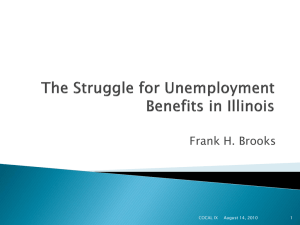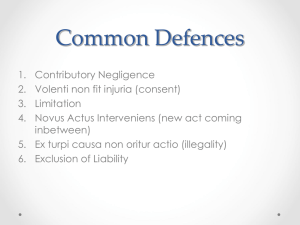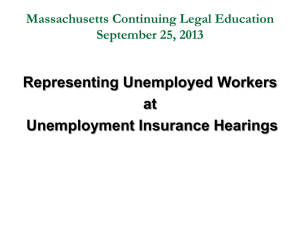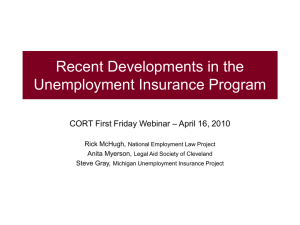Unemployment Insurance in Higher Education Power Point
advertisement
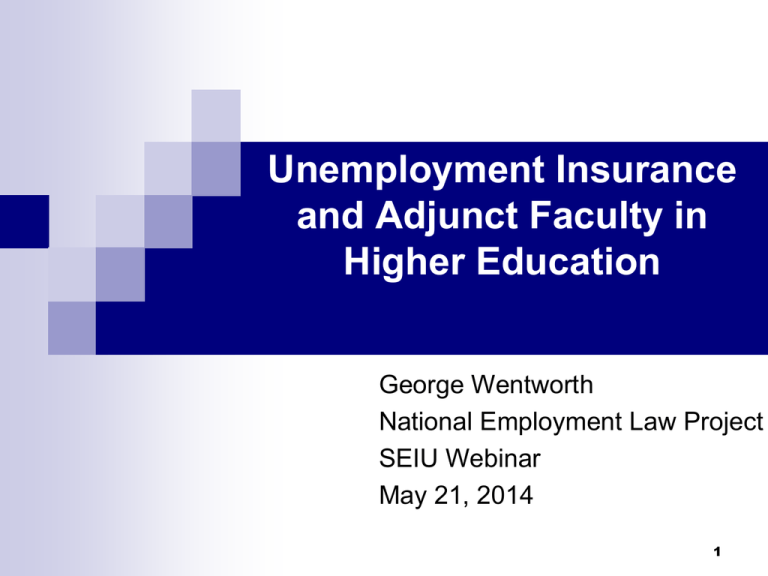
Unemployment Insurance and Adjunct Faculty in Higher Education George Wentworth National Employment Law Project SEIU Webinar May 21, 2014 1 Today’s Agenda Unemployment Insurance (UI)- Process Overview UI Law and Educational Employment What is a “Reasonable Assurance”? Reasonable Assurance and Adjuncts Appeals Related Eligibility Issues 2 Goals of Unemployment Insurance (UI) Program 3 Provide partial income replacement for workers who are involuntarily unemployed Stimulus for local economies: maintains consumer spending & prevents ripple effects on area businesses Promotes attachment of unemployed workers to the labor market & sometimes specific employers UI Benefits: Coverage & Financing State UI laws extend to employees of private and public sector employers, tribal governments and most nonprofit organizations Private sector employers pay quarterly unemployment taxes that are “experience-rated” – tied to the employer’s level of experience with unemployment (More layoffs= higher UI taxes) Most public sector employers participate in state UI programs on a reimbursing basis – meaning they pay dollar-for-dollar the actual costs of benefits paid to former employees who are determined eligible for benefits 4 Applying for Benefits In most states, UI claim-filing is by phone or on-line (In a few states, can still apply in person.) Information you should have when filing: Social Security number Complete mailing address with zip code A telephone number For each employer over the last 18 months: Employer’s name and address Last day of work with each employer. Monetary Entitlement: Establishing a Weekly Benefit Rate 6 Calculation based on wages paid in a Base Period. Base period is typically the first 4 of the last 5 completed calendar quarters. State laws usually require (a) minimum earnings to establish a benefit rate, as well as (b) a test that insures there are wages in more one than one calendar quarter in the base period. Weekly benefit amount intended to approximate 50% of pre-layoff weekly earnings (up to statutory maximum) Congress Excludes Certain School Employees from UI Eligibility 1976 Federal Unemployment Tax Act (FUTA) Amendments: Congress amended federal law in 1976 to cover all persons working for state and local government, including employees of educational institutions BUT excluded compensation for employees of educational institutions working in professional and principal administrative capacities between terms if there was reasonable assurance of reemployment in the following term 1977: Congress amended federal law to add denials for established vacation periods or holiday recesses The Law Federal Unemployment Tax Act (FUTA) §3304(a)(6)(A) Federal law requires states to deny UI benefits to professional employees of educational institutions between academic years or terms and during established and customary vacation periods or holiday recesses within terms if: (1) such individual performs such services in the first of such academic years (or terms) and (2) there is a contract or reasonable assurance that such individual will perform services in any such capacity for any educational institution in the second of such academic years or terms. 8 Educational Institutions The federal law governing exclusion of educational employment wages applies when: The institution is approved, licensed or issued a permit to operate as a school by an authorized governmental agency, and The institution is subject to taxation as a government entity or as a non-profit organization. 9 Affected Workers Any claimant who is employed by an educational institution and who is filing between or within terms Educational employees fit into one of the following categories: Instructional, research or principal administrative or Other capacity 10 Instructional, Research or Principal Administrative Employees Professors Adjunct professors Teachers Substitute Teachers Paraprofessionals Tutors Principals Provosts Deans 11 Contract or Reasonable Assurance? In order for the claimant to be denied benefits, there must be a contract or reasonable assurance of being rehired. For “professional employees”, there is often a contract of employment for the following academic year or term. If there is not a contract (or tenure), the issue is whether the claimant has a “reasonable assurance” of reemployment in the ensuing academic year or term. 12 What is “Reasonable Assurance”? Reasonable assurance means that: The individual has a written, verbal or implied agreement that s/he will perform services in the same or similar capacity during the ensuing academic year, term, or remainder of the term. There is a bona fide offer of employment, not just a possibility that employment will exist. In addition, reasonable assurance exists only if the economic terms and conditions of the job offered in the second period are not substantially less (as determined by state law) than the terms and conditions for the job in the first period 13 Reasonable Assurance State UI agency required to determine whether the claimant has reasonable assurance of continuing employment with an educational institution after the break. Exists when there has been an affirmative offer of employment under terms and conditions that are not substantially less than those under which s/he performed services for the educational institution prior to the school break. Determination based on factual situation that exists at the time a particular claim for a week of benefits is filed; can be subject to change 14 Reasonable Assurance Reasonable assurance exists even if the claimant responds to the employer’s offer by stating that s/he did not want to be considered for future assignments in the following school year. A claimant’s failure to respond to the employer's communication or his/her refusal of an offer of employment does not negate reasonable assurance. 15 Reasonable Assurance Conditional factors outside the claimant’s control may negate a finding of reasonable assurance Offer dependent on course enrollment Offer dependent on budget approval 16 Method of Disqualification Differs from other forms of disqualification that deny benefits outright Instead excludes wages earned in educational employment from the base period wages used in the monetary calculation of the claimant’s weekly benefit amount. Claimant subject to exclusion of educational wages may have other non-educational wages that can be used to establish UI eligibility. 17 When is Educational Employment Disqualification Applicable? 1. The claimant has base period wages from an educational institution and 2. The claimant is filing for benefits during a period that falls between academic years or terms, scheduled vacation, holiday recess or sabbatical and 3. There is a reasonable assurance that the claimant will return to work to perform services for an educational institution following the school vacation or break 18 Reasonable Assurance - Adjuncts Conditional factors will not override a finding of reasonable assurance if the claimant generally has an established pattern of returning to work for the educational employer. Unlike full-time salaried faculty, adjunct faculty are only paid for the courses which are specified in the contract. Classes are usually contingent upon enrollment and are often subject to budgetary issues. State UI agency will typically review adjunct’s work history with educational employer. If claimant has a history of returning to teach at least one course, agency will generally find reasonable assurance. 19 Adjuncts & Contingent Offers of Work There is inconsistency within states on finding “reasonable assurance” when adjunct is offered reemployment contingent on adequate enrollment or budgetary considerations Some disparity in whether the terms and conditions of the employment being offered are substantially less favorable than the employment in prior year or term Most states will consider “totality of circumstances” including: Historical pattern of course being cancelled or not Outside evidence that suggests less certainty of reemployment than in prior years Evidence of markedly inferior terms/conditions of employment being offered 20 2 States with Favorable Laws on Reasonable Assurance (WA) Washington Rev. Code 50.44.053: Individuals who are not tenured and do not work in tenure-track positions on an annual salary basis, and who receive an offer of employment that is conditioned on enrollment, funding, program changes, or other factors outside of the individual’s control, are presumed not have reasonable assurance. In such situations, an employer has the burden to provide sufficient documentation to overcome this presumption. Reasonable assurance must be determined on a case-by-case basis by the total weight of evidence, but primary weight must be given to the contingent nature of an offer of employment. 21 2 States with Favorable Laws on Reasonable Assurance (CA) California Unemployment Ins. Code 1253.3 (g): “‘reasonable assurance’ includes, but is not limited to, an offer of employment or assignment made by the educational institution, provided that the offer or assignment is not contingent on enrollment, funding, or program changes.” 22 Appeals Process A claimant who has been denied benefits can appeal and seek an informal trial before an Administrative Law Judge (ALJ). The ALJ will decide whether or not the state agency’s determination is correct. All state appeal systems have statutory deadlines. It is critical to file appeals timely or ALJ’s will dismiss case for lack of jurisdiction. Claimants can review their case file once a hearing is requested. 23 Appeals Hearing 24 Due Process/Fair Hearing Rights: Notice of issue(s) to be heard Right to be represented Right to present witnesses Subpoena (compel production of evidence, documents not readily available) Review and discuss any document before the ALJ accepts it for the record ALJ Hearing and Decision While documentation of original denial is part of record, most UI appeals start from scratch in terms of developing the facts ALJ will usually direct questioning and exercise obligation to develop all necessary facts to decide case. Written findings and decision of law Can be appealed to 2nd level administrative body What to do while appeal is pending and after the hearing? 25 Continue to certify every week (or bi-weekly). If the claimant does not continue to certify that he is able & available for work, claimant may forfeit benefits for that period even if he ultimately prevails in appeal. A “Notice of Decision” should be mailed within 2-3 weeks after the hearing Ongoing Eligibility - Able and Available for Work After filing initial application, claimant must file weekly (or biweekly) claims by phone or on-line, certifying that the claimant is: 1. Able to work (physically able to perform work) 2. Available for suitable work (work qualified to perform by education or past work) 3. Actively seeking work (employer contact documentation varies by state) 4. Do Not Refuse Suitable Work Availability For Work In majority of states, claimant satisfies availability for work requirement if s/he is available for work for the days and hours that worked in their recent work history (base period) However, some states still require that UI claimants be available for full-time work as a condition of eligibility for benefits. These states are AL, AK, AZ, CT, DC, GA, IL, IN, KY, MI, MS, MO, OH, OR, TN, TX, UT, VA, WV, WI 27 For More Information: Contact: George Wentworth NELP 75 Maiden Lane Suite 601 New York, NY (860) 257-8894 gwentworth@nelp.org Questions? 29




